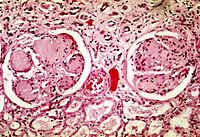
Photo from wikipedia
Increased protein glycation, oxidation and nitration is linked to the development of diabetic nephropathy. We reported levels of serum protein glycation, oxidation and nitration and related hydrolysis products, glycation, oxidation… Click to show full abstract
Increased protein glycation, oxidation and nitration is linked to the development of diabetic nephropathy. We reported levels of serum protein glycation, oxidation and nitration and related hydrolysis products, glycation, oxidation and nitration free adducts in patients with type 1 diabetes (T1DM) during onset of microalbuminuria (MA) from the First Joslin Kidney Study, a prospective case–control study of patients with T1DM with and without early decline in GFR. Herein we report urinary excretion of the latter analytes and related fractional excretion values, exploring the link to MA and early decline in GFR. We recruited patients with T1DM and normoalbuminuria (NA) (n = 30) or new onset MA with and without early GFR decline (n = 22 and 33, respectively) for this study. We determined urinary protein glycation, oxidation and nitration free adducts by stable isotopic dilution analysis liquid chromatography-tandem mass spectrometry (LC–MS/MS) and deduced fractional excretion using reported plasma levels and urinary and plasma creatinine estimates. We found urinary excretion of pentosidine was increased ca. twofold in patients with MA, compared to normoalbuminuria (0.0442 vs 0.0103 nmol/mg creatinine, P < 0.0001), and increased ca. threefold in patients with early decline in GFR, compared to patients with stable GFR (0.0561 vs 0.0176 nmol/mg creatinine, P < 0.01). Urinary excretion of all other analytes was unchanged between the study groups. Remarkably, fractional excretions of 6 lysine and arginine-derived glycation free adducts were higher in patients with early decline in GFR, compared to those with stable GFR. Impaired tubular reuptake of glycation free adducts by lysine and arginine transporter proteins in patients with early GFR decline is likely involved. We conclude that higher fractional excretions of glycation adducts are potential biomarkers for early GFR decline in T1DM and MA. Measurement of these analytes could provide the basis for identifying patients at risk of early decline in renal function to target and intensify renoprotective treatment.
Journal Title: Scientific Reports
Year Published: 2020
Link to full text (if available)
Share on Social Media: Sign Up to like & get
recommendations!